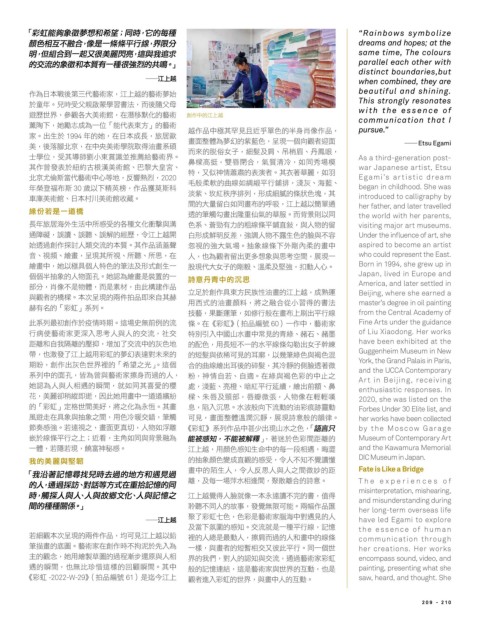Page 249 - 亚洲二十世纪及当代艺术
P. 249
ࠀঐᅄྫྷซձҎૐiΝࣛd̴ٙӊ၇ “Rainbows symbolize
ᕙЍʝʔፄΥd྅݊ɓૢૢ̻Бᇞdޢࠢʱ dreams and hopes; at the
dШଡ଼ΥՑɓৎɦܘߕᘆ৪ڥdவၾҢӋ same time, The colours
ٙʹݴٙᅄձ͉ሯϞɓ၇ܘ੶डٙჼf parallel each other with
distinct boundaries,but
{ Ϫɪ൳
when combined, they are
Ъމ˚͉ܝୋɧ˾ᖵஔdϪɪ൳ٙᖵஔྫྷ beautiful and shining.
ഁϋfՅࣛա˨ፋ઼ႆኪ୦ࣣجdϾܝᎇ˨͎ This strongly resonates
༷ዝ˰ޢdਞᝈɽߕஔdίᆑᎰʷٙᖵஔ ௴ЪʕٙϪɪ൳ with the essence of
communication that I
ᔠௗɨdμᎸқϓމɓЗঐ˾ڌ؇˙ٙᖵஔ pursue.”
f̈͛ 1994 ϋٙμdί˚͉ϓڗd֢ࣚᆄ ൳ЪۜʕՉӼԈ˲ڐ˷ఊЍٙ̒Ԓӽ྅Ъۜd
ߕdܝໝ໔̏ԯdίʕ̯ߕஔኪ৫՟ذӻ၂ ࠦމྫྷˌٙഓᔝЍdяତɓࡈΣᝈ٫ڎࠦ — Etsu Egami
ɻኪЗdաՉኬࢪᄎʃ؇ሧᗆԨપᑥഗᖵஔޢf ϾԸٙ୭ڳɾɿdቻʿٲeΞeʗჾd As a third-generation post-
ՉЪಀ೯ڌॲߒ࣬̚ဏߕஔeˋኇɽެe ᄀᆃ৷࣎dᕐࡶௐΥdंሯиdνΝӸఙᅼ war Japanese artist, Etsu
̏ԯˈࡐ˾ᖵஔʕːഃήdˀᚤᆠडd2020 तdɦЧग़ઋጽഠٙڌစ٫fՉВഹശᘆdνϻ Egami’s ar tistic dream
ϋ೮၅̺ 30 ๋˸ɨၚߵdЪۜᐏ߅ ˣছݓழٙϜᇞνၦᇟ̻Бરdϲeऎᔝe began in childhood. She was
ԓࢫߕஔe˚͉Ӏʇߕஔϗᔛf ૱ഓeٓߎॣҏરΐdҖϓጰٙૢًЍ෯dՉ introduced to calligraphy by
ගٙɽඎवͣνΝ̺ٙխіdϪɪ൳˸ᔊఊஷ her father, and later travelled
ᇝ΅߰݊ɓ༸ ீٙഅᙃʵ̈ඤࠠ̀ंٙശfϾߠ౻ۆ˸Ν the world with her parents,
ڗϋ֢ࣚऎ̮͛ݺʕהชաٙ၇˖ʷላᏘၾ๖ ЍӻeႏۊϞɢٙᇞૢ̻ٜાdၾɛيٙव visiting major art museums.
ஷღᖟdႬᛘeႬᛓeႬ༆ٙዝd˿Ϫɪ൳ක ͣҖϓᒻˀࢨd੶ሜɛيʔᚣ͛Ѝٙᑕၾʔ࢙ Under the influence of art, she
ீཀ௴Ъઞীɛᗳʹݴ͉ٙሯfՉЪۜႊᑊ ׁൖٙ੶ɽंఙfפᇞૢɨ̮ʫݓٙʕ aspired to become an artist
ࠪeൖ᎖eᖭdяତՉהൖeהᛓeהܠdί ɛdɰމᝈ٫व̈һεซၾܠϽ٤ගd࢝ତɓ who could represent the East.
ᖭʕdμ˸ՈࡈɛतЍٙഅجʿҖό௴͛ɓ ٰତ˾ɽɾɿٙᆇeݓʿ੶dϔਗɛːf Born in 1994, she grew up in
ࡈࡈ̒פٙɛيࠦˆfμႩމᖭ݊ༀໄٙɓ ་จʗڡʕٙӐܠ Japan, lived in Europe and
ʱdӽ྅ʔ݊يdϾ݊९ҿd͟ϤܔЪۜ America, and later settled in
ၾᝈ٫ٙᆃf͉ϣяତٙՇשۜуԸІՉႺ ͭԑ௴ЪՈ؇˙͏ૄذٙϪɪ൳dϓᆞ༶ Beijing, where she earned a
master’s degree in oil painting
ႺϞΤٙࠀӻΐf ͜Гόٙذᕙࣘdਗ਼ʘፄΥʃ୦ࣣٙج
Ҧᖵd؈ᓙ༶അdνࡌБছί̺ɪՏ̻̈Бᇞ from the Central Academy of
Ϥӻΐ௰ڋ௴Ъޥઋࣛಂfவఙ̦ೌۃԷٙݴ ૢfίࠀשۜᇜ 60ɓЪʕdᖵஔ Fine Arts under the guidance
БषԴᖵஔһଉɝܠϽɛၾɛٙʹݴdٟʹ तйˏɝʕʆ˥ʕ੬Ԉٙڡၠeሱͩeሱኈ of Liu Xiaodong. Her works
൷ᕎձІҢཞᕎٙᏀҵdᄣ̋əʹݴʕٙϲЍή ٙৣЍd͜ڗʔɓٙ˥̻ᇞૢʵਔ̈ɾɿᇖ have been exhibited at the
੭dɰዧ೯əϪɪ൳͜ࠀٙྫྷˌڌ༺࿁͊Ըٙ ٙቻၾԱ̙ԈٙЀ࿊d˸അၠЍၾሌЍ૿ Guggenheim Museum in New
ಂd௴Ъ̈ϲЍ˰ޢ༁ٙҎૐʘΈfவࡈ ΥٙϜᇞᖭ̈ЀܝٙຟቻdՉи᎑ٙਉᑕீഹฆ York, the Grand Palais in Paris,
and the UCCA Contemporary
ӻΐʕٙࠦˆdޫމಀၾᖵஔᏜԒϾཀٙɛd ४dग़ઋІ߰eІቇfίၠၾሌЍٙʕ˟ʘ Art in Beijing, receiving
μႩމɛၾɛ༾ٙᐛගdఱνΝՉఃฌٙᙶ ஈdᔝeڥዐeฮߎ̻Бַᚃdᖭ̈ۃᕘeᄀ enthusiastic responses. In
ڀdߕᘆۍᐽуdΪϤμ͜ʕɓ༸༸ᘰॸ ᆃeϡࡶʿ᎕dࡶᖙฆੵdɛي྅ίჀჀྖ 2020, she was listed on the
ٙࠀ֛ࣸ˰ගߕλdਗ਼ʘʷމ͑ܩfՉ ࢹdɝӐܠf˥تছΣɨݴਗٙذ༦ᜳਗ Forbes Under 30 Elite list, and
༷ࠬԐίՈၾפʘගd͜Ѝиาʹ፹dഅᙃ ̙ԈdࠦᆗӐ᎑d࢝ତ་จছٙᗲܛf her works have been collected
ື۱ช੶f߰Ⴣൖʘdࠦһॆʲdɛيνओᎉ ࠀӻΐЪۜʕޟˇ̈ତʆ˥ʘЍdႧԊ̥ by the Moscow Garage
లᇞૢ̻Бʘɪiڐd˴ԉνΝၾߠ౻ፄމ ঐชٝdʔঐ༆ᙑdഹЍග൷ᕎٙ Museum of Contemporary Art
ɓd߰ᒯ߰ତdᙘబग़।ชf Ϫɪ൳d͜ᕙЍชٝ͛նʕٙӊɓݬ༾dૌᏼ and the Kawamura Memorial
Ңٙߕᘆၾද ٙפᕙЍᜊϓٜᝈٙชաd˿ɛʔٝʔᙂᛘᏑ DIC Museum in Japan.
ҢضഹাኳరҬՅ̘ࣛཀٙή˙ձ༾Ԉཀ ʕٙࠤ͛ɛd˿ɛˀܠɛၾɛʘගฆѶٙ൷ Fate is Like a Bridge
ٙɛdஷཀમஞe࿁༑ഃ˙όίࠠܽাኳٙΝ ᕎdʿӊɓఙറ˥ுගdၳᕎΥٙ་จf T h e e x p e r ie n c e s of
ࣛdᙃઞɛၾɛeɛၾ݂ඊ˖ʷeɛၾাኳʘ Ϫɪ൳ᙂɛᑕఱ྅ɓ͉͑Ⴣᛘʔҁࣣٙd࠽ misinterpretation, mishearing,
ගٙ၇၇ᗫڷf ୩ᛓʔΝɛ݂ٙԫd೯ᙂೌ̙ࠢঐfՇషЪۜි and misunderstanding during
her long-term overseas life
ၳəࠀɖЍdЍ݊ᖵஔ໘ऎʕ࿁༾Ԉٙɛ
{ Ϫɪ൳ have led Egami to explore
ʿɨ؟ఖٙชٝfʹݴఱ݊ɓ၇̻Бᇞdাኳ the essence of human
߰ᝈ͉ϣяତٙՇЪۜdѩ̙ԈϪɪ൳˸ད ༁ٙɛᐼ݊௰ਗɛdᏜٲϾཀٙɛձʕٙᇞૢ communication through
അֵٙྡfᖵஔί௴Ъࣛʔإɝމ ɓᅵdၾ٫ٙᅲʹɦ־Ϥ̻БfΝɓࡈ˰ her creations. Her works
˴ٙᝈׂdμ͜ᖭႡণྡٙཀနӉᒔࡡၾɛ ޢٙҢࡁd࿁ɛٙႩٝၾʹݴdஷཀᖵஔࠀ encompass sound, video, and
༾ٙᐛගdɰೌˢޜவᅵٙΫᚥᐛගfՉʕ ছٙাኳஹഐdவ݊ᖵஔၾ˰ޢٙʝਗdɰ݊ painting, presenting what she
ࠀ -2022-W-29שۜᇜ 61݊ԙʦϪɪ ᝈ٫ආɝࠀٙ˰ޢdၾʕɛٙʝਗf saw, heard, and thought. She
20 9 - 21 0

